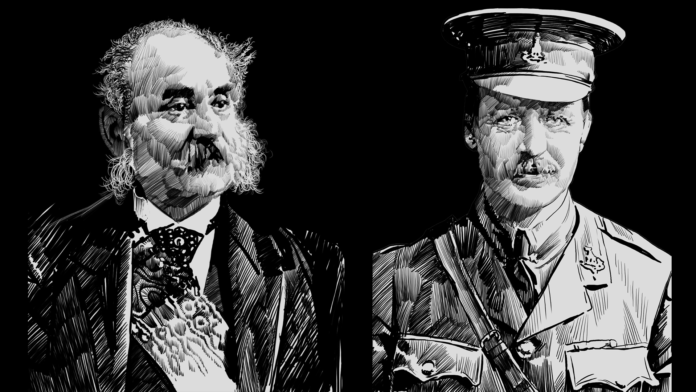Dr. Mohsen Mohammad Saleh, Director of the Al-Zaytouna Centre for Studies and Consultations, explores the authenticity of the controversial “Campbell-Bannerman Document” in his article Is the Campbell-Bannerman Document Real or Fabricated? Saleh notes that no conclusive evidence confirms the existence of this secret document, allegedly attributed to British Prime Minister Henry Campbell-Bannerman. The document purportedly emerged from a 1907 London conference attended by colonial powers—Britain, France, the Netherlands, Belgium, Spain, and Italy—to maintain dominance over the Arab world by establishing a buffer state between Arab Asia and Arab Africa, loyal to colonial interests.
Saleh points out that although many writers have referenced this document, its authenticity remains uncertain. Governments may withhold documents to protect their interests, and it is unlikely that the creators of conspiracies would voluntarily disclose their schemes.
Regardless of the document’s authenticity, Saleh argues that the current fractured Arab state is undoubtedly the result of long-standing international conspiracies orchestrated by global Zionism and Western imperialists. The roots of this fragmentation lie in the fall of the Islamic Caliphate in 1924 and the spread of nationalism—a concept originating in the West, leading to two world wars that claimed millions of lives. Unfortunately, this nationalist ideology seeped into the Muslim world, dismantling the unity of the Islamic community into smaller, dependent nations under Western and Zionist influence.
The fall of the Ottoman Caliphate coincided with the rise of the Young Turks, a nationalist movement that sought to impose Turkish nationalism on Arabs and other ethnic groups.
This imposition sparked resistance among Arabs, especially in the Levant, where figures like Nasif al-Yaziji and Boutros al-Bustani adopted Arab nationalism to counter Turkish domination.
This cultural conflict between Arabs and Turks led to growing tensions, eroding the concept of a unified Islamic Caliphate that embraced all ethnicities. Prophet Muhammad’s words, which emphasized equality regardless of race or ethnicity, were disregarded during this period:
“O people, your Lord is One, and your father is one. An Arab has no superiority over a non-Arab, nor a non-Arab over an Arab, nor a white over a black, nor a black over a white, except by piety.”
The tensions worsened with the appointment of Ahmed Jamal Pasha, known as “The Butcher,” as governor of the Levant.
His brutal suppression of dissent included torturing opponents and executing Arab intellectuals who resisted forced Turkification.
On May 6, 1916, notable figures such as Prince Omar al-Jaza’iri, poets Shafiq al-Azm and Rafiq Rizq Salloum, and journalists Abdul Hamid al-Zahrawi and George Haddad were executed in Damascus and Beirut, leaving a lasting scar on Arab history.
In response to growing Arab nationalism, the Great Arab Revolt against the Ottoman Empire began on June 10, 1916, led by Sharif Hussein of Mecca with British support.
This revolt aligned with the broader scheme of Zionism and Western imperialism, as revealed by the secret Sykes-Picot Agreement in 1916. This agreement divided the Ottoman Arab provinces between Britain and France, establishing spheres of influence and laying the groundwork for the geopolitical fragmentation of the Arab world.
Britain was allocated Palestine, including its Mediterranean ports in Haifa and Acre, as well as Jordan and southern Iraq, while France took control of southeastern Turkey, northern Iraq, Syria, and Lebanon.
The Prophet Muhammad foresaw this division, warning, “Nations will soon summon one another to attack you, just as people gather around a feast.” When asked if this would be due to a lack of numbers, he replied, “No, but you will be like foam on the sea. Weakness will enter your hearts, and fear will be removed from the hearts of your enemies because you love the world and hate death.”
Unfortunately, Western Crusaders and Global Zionism felt that their initial mission to fragment the Islamic nation was successful. This paved the way for the second phase, what can be called a “second Sykes-Picot,” further intensifying the division of an already fragmented region.
Today, we witness the Zionist entity known as Israel extending its influence over the secular, fractured nations surrounding it within our Arab world. This is achieved with the unlimited support of Western Crusader powers, both European and American, even to the extent of overlooking the Israeli entity’s acts of genocide against the resilient Palestinian people. These war crimes have escalated to the horrific level of burning individuals alive while they were receiving medical treatment in hospitals.
This clearly indicates that Western Crusader powers and Global Zionism have begun implementing the second phase of the Sykes-Picot agreement, aimed at further dividing and seizing lands from our Arab homeland to establish what is called “Greater Israel.” This would leave the region as a cancerous entity that spreads unchecked, like a disease ravaging a weakened body.
So, what is the solution?




